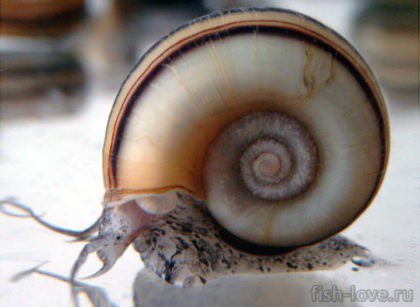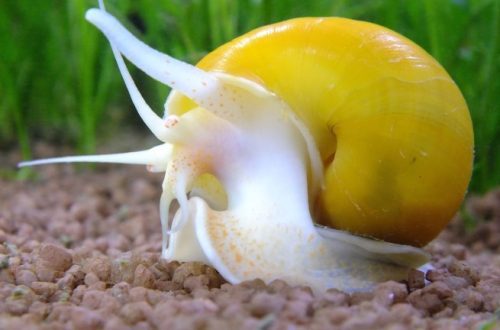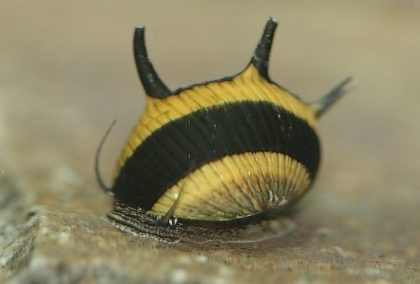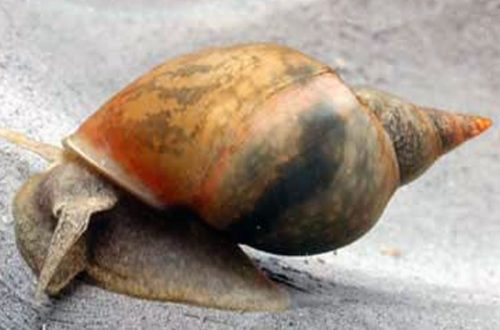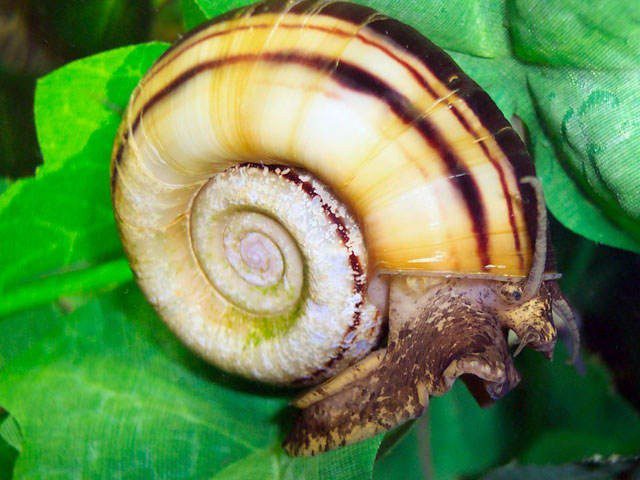
Mariza: maintenance, breeding, compatibility, photo, description

One of the cutest representatives of aquarium snails is the mariza snail. In nature, it lives in warm fresh waters of South America: in Brazil, Venezuela, Honduras, Costa Rica. Due to its ability to instantly absorb algae, mariza began to be used in the middle of the last century to clean water bodies affected by plants.
The beautiful appearance of the snail helped her to gain a strong position among the aquarium inhabitants. Keeping and breeding marises, contrary to popular belief, is quite simple, and for a successful life of a mollusk in your aquarium, you just need to follow a few simple rules.
Contents
Description
Maryse is a rather large mollusc. It can reach approximately 20 millimeters in width and 35-56 millimeters in height. The snail shell is pale yellow or brownish in color and has 3-4 whorls. Usually there are dark, almost black lines along the course of the whorls, but there are individual individuals without stripes.
Body color varies from yellowish to dark speckled to brown. Often it is two-tone – a light top and a dark bottom. Maryse has a breathing tube that allows her to breathe atmospheric air.
If all aquarium conditions are met, mariza will live up to 2-4 years.
Conditions for keeping the mariz snail
There are no problems with food for the aquarium snail mariz. They eat pieces of dead plants, bacterial plaque, caviar of other animals, dry food. Snails actively eat live plants, so they are not very suitable for herbalists’ aquariums. In general, they are considered quite gluttonous.
To prevent snails from eating all the vegetation, you need to actively feed them, especially with aquarium mixtures and flakes.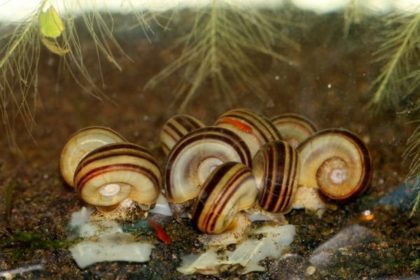
In many ways, these molluscs are unpretentious, but there are certain requirements for water content. The optimal indicators are the temperature of 21-25 degrees, they are very sensitive to lower water. Hardness parameters – from 10 to 25 degrees, acidity – 6,8-8. If the water in the vessel does not meet the required standards, then the snail’s shell begins to collapse and soon it dies.
These mollusks are bisexual, males are light beige with brown speckles, and females are dark brown or chocolate with stains. Caviar is laid out under the leaves and after a couple of weeks young individuals appear from it. The number of eggs is up to a hundred pieces, but not all mollusks survive. It is important to control the growth of the population manually – to transfer eggs and young animals to a separate container.
Marises are peaceful and calm inhabitants who get along with many types of fish. But, in order to save mariz, it is not recommended to settle them together with cichlids, tetraodons and other large individuals.
The life span of a snail is on average 4 years. If you create appropriate conditions for mariza and feed it with special flakes, it will actively spawn, benefit from cleaning the aquarium, and brighten it up.
Appearance
At first glance, it would seem that there is nothing unusual in these sea and river inhabitants, they are all the same and wordless. But true lovers say that each snail has its own character and its own preferences.
For example, a snail, beautifully and romantically named mariza, is a mollusk that came to us from the fresh rivers of South America. In all lakes, swamps and rivers of Brazil, Venezuela, Panama, Honduras and Costa Rica, you can find a large number of these mollusks.
They love areas with rich vegetation and a generous tropical climate. They have an extremely attractive appearance: a large spiral shell, painted in delicate colors of the warm spectrum, is decorated with several longitudinal stripes.
The body of the snail is yellowish-white with grey, black and green patterns, and is often two-tone: beige on top and dark brown on the underside. Large marizes can reach 5 cm.
Feeding
Under no circumstances should the Maryse be left hungry. Its range is quite wide:
- leftover fish food
- fish droppings;
- protozoan algae;
- bacteria;
- dead sea animals;
- caviar of other molluscs.

With pleasure they eat standard marine food and tableted seaweed. If the snails get hungry and find nothing edible, then they will consider all aquarium plants as food. Moreover, they will eat them at the root, so that there will be nothing left.
Therefore, in order to avoid eating expensive aquarium plants, you should constantly put edible mixtures in the form of flakes on the bottom.
Reproduction
Unlike many other molluscs, marizas are bisexual, and you can guess their sex by color. Males have a light beige body with small brown speckles, while females are dark brown or chocolate with stains.
These snails reproduce quickly. Caviar is laid under the underside of the leaf of any aquarium plant. The location of the sheet does not matter. The eggs reach a diameter of 2 to 3 mm.
After two to two and a half weeks, they become transparent and young snails emerge from them. You need to manually regulate the growth of the population in the aquarium: remove excess eggs or transfer young individuals to a separate container.
It cannot be said that the mollusks that have just been born are all viable. A very large percentage of them die.
Compatibility
Marises are completely peaceful in relation to other inhabitants of the creation aquarium. They are calm and get along well with almost all types of fish and aquarium animals. The exceptions are fish such as cichlids, tetraodons and other species that are dangerous for the snails themselves, because they are not averse to eating them.
With algae, things are a little different. If you regularly feed the snail, it will not touch aquarium plants. But still, in order to avoid risk, it is better not to start mariz in aquariums with a large number of plants, especially expensive and rare ones.
Interesting Facts
- It is believed that large snails get used to their owner and begin to recognize him.
- Marises slowly and smoothly move around the aquarium, and it is a great pleasure to watch them, which really fascinates and soothes no worse than a relaxation session with a psychologist.
- Doctors have not noted a single case of allergy to snails. And it is believed that the mucus of molluscs is healing: cuts and small wounds on the hands heal much faster if you let the snails crawl a little over the damaged surface.
Those who do not dare to have pets because of fear of dirt, smell or noise should know that mariza clams do not smell of anything, do not make noise, do not gnaw on home shoes and furniture, do not scratch floors, and you do not need to walk with them in the mornings or evenings. Many shellfish lovers joke that aquarium inhabitants are lazy animals.
Even if at first the idea of having snails or shellfish seems ridiculous to you, think maybe these little creatures will reveal something new to you about the world around you!



